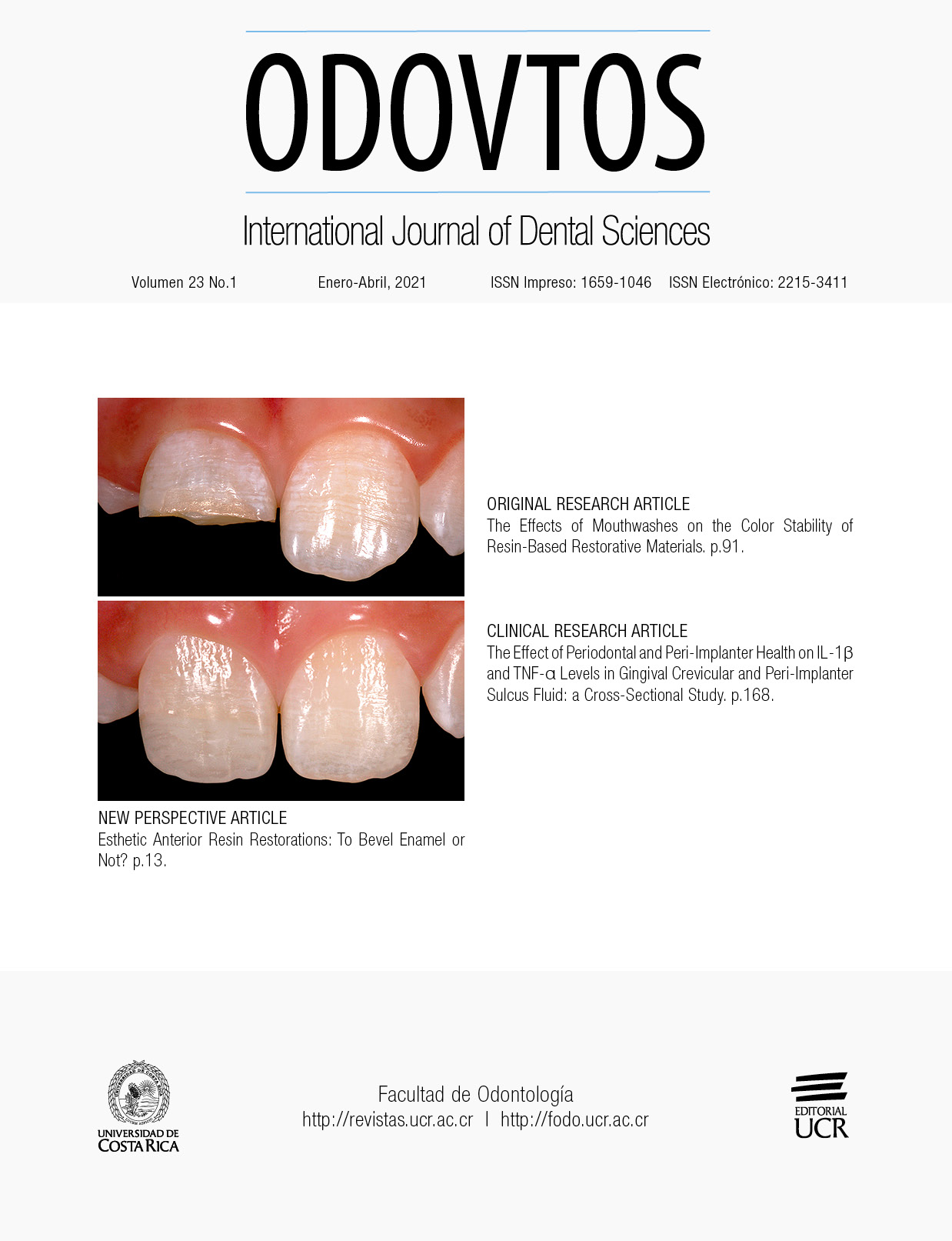Resumen
La impresión intraoral permite al odontólogo obtener directamente los datos de las piezas dentales que se requiera rehabilitar, otorgándole mayor precisión y eliminando así de la fase clínica la toma de impresión y la fabricación del modelo, aspectos sensibles a errores. El objetivo de la presente revisión es identificar el sistema de impresión digital intraoral más preciso y además identificar los factores que afectan a la precisión de esta en odontología restauradora. Mediante una revisión bibliográfica con búsqueda en las bases de datos de PubMed y Embase se obtuvieron 153 artículos, luego de la evaluación cualitativa se incluyeron en la revisión 14 que cumplieron con los criterios de inclusión y exclusión. Se determinó que la experiencia del dentista, la convergencia en la preparación dental y la terminación cervical son determinantes al momento de la toma de impresión digital, sin embargo, el uso o no de polvo no es relevante. El sistema de impresión digital Lava C.O.S., iTero y True definition son los más precisos dependiendo siempre del tipo de rehabilitación a realizar.
Citas
Birnbaum N. S., Aaronson H. B. Dental impressions using 3D digital scanners: virtual becomes reality. Compend Contin Educ Dent. 2008; 29 (8): 494, 496, 498-505.
Zarauz Yáñez C., Pradíes Ramiro G., I U. C. de M. F. de O. D. de E. Estudio comparativo “in vivo” de un sistema de impresión convencional con elastómeros vs. un sistema de impresión digital (ITERO): Trabajo de investigación. 2012. España.
Brawek P. K., Wolfart S., Endres L., Kirsten A., Reich S. The clinical accuracy of single crowns exclusively fabricated by digital workflow the comparison of two systems. Clin Oral Investig. 2013;17 (9): 2119-25.
da Costa J. B., Pelogia F., Hagedorn B., Ferracane J. L. Evaluation of different methods of optical impression making on the marginal gap of onlays created with CEREC 3D. Oper Dent. 2010; 35 (3): 324-9.
Logozzo S., Zanetti E. M., Franceschini G., Kilpelä A., Mäkynen A. Recent advances in dental optics. Part I: 3D intraoral scanners for restorative dentistry. Opt Lasers Eng [Internet]. 2014; 54 (0): 203-21.
Quaas S., Rudolph H., Luthardt R. G. Direct mechanical data acquisition of dental impressions for the manufacturing of CAD/CAM restorations. J Dent. 2007; 35 (12): 903-8.
Dehurtevent M., Robberecht L., Behin P. Influence of dentist experience with scan spray systems used in direct CAD/CAM impressions. J Prosthet Dent. 2015; 113 (1): 17-21.
Miyazaki T., Hotta Y., Kunii J., Kuriyama S., Tamaki Y. A review of dental CAD/CAM: current status and future perspectives from 20 years of experience. Dent Mater J. 2009; 28 (1): 44-56.
Güth J. F., Keul C., Stimmelmayr M., Beuer F., Edelhoff D. Accuracy of digital models obtained by direct and indirect data capturing. Clin Oral Investig. 2013; 17 (4): 1201-8.
Seelbach P., Brueckel C., Wöstmann B. Accuracy of digital and conventional impression techniques and workflow. Clin Oral Investig. 2013; 17 (7): 1759-64.
Ng J., Ruse D., Wyatt C. A comparison of the marginal fit of crowns fabricated with digital and conventional methods. J Prosthet Dent. 2014; 112 (3): 555-60.
Syrek A., Reich G., Ranftl D., Klein C., Cerny B., Brodesser J. Clinical evaluation of all-ceramic crowns fabricated from intraoral digital impressions based on the principle of active wavefront sampling. J Dent. 2010; 38 (7): 553-9.
Tidehag P., Ottosson K., Sjögren G. Accuracy of Ceramic Restorations Made Using an In-office Optical Scanning Technique: An In Vitro Study. Oper Dent. 2013; 308-16.
Almeida e Silva J. S., Erdelt K., Edelhoff D., Araújo É., Stimmelmayr M., Vieira L. C. C., et al. Marginal and internal fit of four-unit zirconia fixed dental prostheses based on digital and conventional impression techniques. Clin Oral Investig. 2014; 18 (2): 515-23.
Tamim H., Skjerven H., Ekfeldt A., Rønold H. J. Clinical evaluation of CAD/CAM metal-ceramic posterior crowns fabricated from intraoral digital impressions. Int J Prosthodont. 2014;27(4):331–7.
Schaefer O, Decker M, Wittstock F, Kuepper H, Guentsch A. Impact of digital impression techniques on the adaption of ceramic partial crowns in vitro. J Dent. 2014; 42 (6): 677-83.
Svanborg P., Skjerven H., Carlsson P., Eliasson A., Karlsson S., Ortorp A. Marginal and internal fit of cobalt-chromium fixed dental prostheses generated from digital and conventional impressions. Int J Dent. 2014; 2014: 534382.
Scotti R., Cardelli P., Baldissara P., Monaco C. Clinical fitting of CAD/CAM zirconia single crowns generated from digital intraoral impressions based on active wavefront sampling. J Dent. 2011; 1-8.
Hamza T. A., Ezzat H. A., El-Hossary M. M. K., Katamish H. A. E. M., Shokry T. E., Rosenstiel S. F. Accuracy of ceramic restorations made with two CAD/CAM systems. J Prosthet Dent. 2013; 109 (2): 83-7.
Reich S., Kern T., Ritter L. Options in virtual 3D, optical-impression-based planning of dental implants. Int J Comput Dent. 2014; 17 (2): 101-13.
Boeddinghaus M., Breloer E. S., Rehmann P., Wostmann B. Accuracy of single-tooth restorations based on intraoral digital and conventional impressions in patients. Clin Oral Investig. 2015 Feb 20.
Quaas S., Loos R., Rudolph H., Luthardt R. G. Randomized controlled trial comparing direct intraoral digitization and extraoral digitization after impression taking. Int J Prosthodont. 2015; 28 (1): 30-2.
Nedelcu R. G., Persson A. S. K. Scanning accuracy and precision in 4 intraoral scanners: An in vitro comparison based on 3-dimensional analysis. J Prosthet Dent. 2014; 112 (6): 1461-71.
Medina-Sotomayor P., Pascual-Moscardó A., Camps I. Correction: Accuracy of four digital scanners according to scanning strategy in complete-arch impressions. PLoS One. 2018; 13 (12): e0209883.
Medina-Sotomayor P., Pascual-Moscardo A., Camps A. I. Accuracy of 4 digital scanning systems on prepared teeth digitally isolated from a complete dental arch. J Prosthet Dent. 2019; 121 (5): 811-20.
Medina-Sotomayor P., Pascual-Moscardo A., Camps I. Relationship between resolution and accuracy of four intraoral scanners in complete-arch impressions. J Clin Exp Dent. 2018; 10 (4): 0-0.

